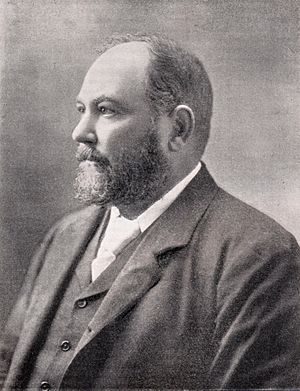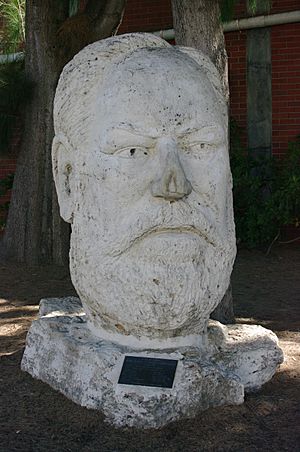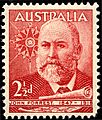John Forrest facts for kids
Quick facts for kids
The Lord Forrest of Bunbury
|
|
|---|---|
 |
|
| 1st Premier of Western Australia | |
| In office 22 December 1890 – 15 February 1901 |
|
| Succeeded by | George Throssell |
| Constituency | Bunbury |
| Personal details | |
| Born | 22 August 1847 Bunbury, Western Australia |
| Died | 2 September 1918 (aged 71) at sea off the coast of Sierra Leone |
| Resting place | Karrakatta Cemetery |
| Political party | Independent (1890–1901), Protectionist (1901–1906), WA Party (1906–1909), Liberal (1909–1917), Nationalist (1917–1918) |
| Spouse | Margaret Elvire Hamersley |
| Signature | |
John Forrest (born 22 August 1847, died 2 September 1918) was a very important person in Australian history. He was a famous explorer, the very first Premier of Western Australia, and a cabinet minister in Australia's first national government.
When he was young, John Forrest became well-known for leading three expeditions into the wild parts of Western Australia. For his amazing work, he received a special award called the Patron's Medal from the Royal Geographical Society in 1876.
Later, he became the Surveyor General. In 1890, he was chosen as the first Premier of Western Australia. This was when Western Australia became a self-governing colony, meaning it could make its own laws. As Premier, Forrest led the state for ten years. During this time, Western Australia grew very quickly. He started many big projects, like building new public structures and helping people settle on land. He also played a key role in making sure Western Australia joined the federation of Australian states.
After Australia became a federation, John Forrest moved into national politics. He held many important jobs, including Postmaster-General, Minister for Defence, Minister for Home Affairs, and Treasurer. He even served as acting Prime Minister for a short time. Just before he passed away, the King approved his new title, Baron Forrest of Bunbury, which is a special honour.
Contents
Early Life and Education
John Forrest was born on 22 August 1847 near Bunbury, Western Australia. He was one of ten children born to Margaret and William Forrest, who had moved to Australia from Scotland.
His parents first worked on a farm in Australind. Later, his father, William, started his own property near the Preston River. He built a windmill and a small house, which is where John was born.
A few years later, the family moved to Picton. There, William built a homestead and a watermill. This mill was mainly used to grind flour, which was very important at the time. The mill was successful, allowing the family to buy more land. This gave them a good social standing in the Bunbury area. The property is still owned by his family today.
John and his brothers first went to a one-room school in Bunbury. They would walk or ride about 4 miles (6.4 km) to get there. His parents really valued education. In 1860, John was sent to Perth to attend Bishop Hale's School. This was the only high school in the colony at the time. He studied there for four years and won several awards for his math skills.
Even though his father, William, wasn't involved in politics, he taught his sons a practical way of looking at life. This was a great gift that helped John and his brothers succeed.
Career Highlights
Becoming a Surveyor
In November 1863, John Forrest began training with a government land surveyor named Thomas Carey. After his training ended in 1865, he became the first person born and educated in the colony to become a qualified land surveyor. He then started working for the government's Lands and Surveys Department.
Famous Expeditions
John Forrest first became known to the public in 1869. He led an expedition into the Australian interior to search for a missing explorer, Ludwig Leichhardt.
The next year, in 1870, Forrest achieved something amazing. He completed the first land crossing from Perth to Adelaide across the vast Nullarbor Plain. His third big expedition in 1874 took him from Geraldton to Adelaide, right through the middle of Australia.
Forrest's expeditions were known for being careful and well-planned. He kept detailed records of everything he saw and did. Because of his incredible work, he received the Patron's Medal from the Royal Geographical Society in 1876.
Leading Western Australia
Forrest's career in politics began when he was promoted to Surveyor General. This was a powerful job that gave him a seat on the colony's executive council.
In 1890, Western Australia gained "responsible government." This meant the colony could govern itself, and John Forrest was appointed as its first Premier. The early 1890s saw a huge increase in population due to the gold rushes. This allowed Forrest's government to start many important public projects. These included building Fremantle Harbour and the Goldfields Water Supply Scheme, which brought water to the goldfields.
Forrest's government also passed several social reforms. He stayed in power through many elections, even before formal political parties were common. His strong support for Federation was very important. It helped Western Australia decide to join the other states to form Australia.
National Politics
In 1901, after Australia became a federation, John Forrest was asked to join the first national government led by Prime Minister Edmund Barton. For the next two decades, he was a member of almost every non-Labor government.
He held many important roles in the federal government:
- Postmaster-General (1901)
- Minister for Defence (1901–1903)
- Minister for Home Affairs (1903–1904)
- Treasurer (1905–1907, 1909–1910, 1913–1914, 1917–1918)
He helped shape Australia's early defence and money policies. He also strongly pushed for the building of the Trans-Australian Railway, which was a project very close to his heart. Forrest briefly served as acting prime minister in 1907. In 1913, he almost became the leader of the Liberal Party, losing by just one vote. In 1918, Prime Minister Billy Hughes suggested that Forrest be given a special title as a peer. However, Forrest died before this could be officially confirmed.
Later Life and Passing
John Forrest had been unwell with cancer since early 1917. By 1918, he was very sick. He stepped down as Treasurer on 21 March 1918. Soon after, he boarded a ship for London, hoping to get special medical care. He also hoped to take his seat in the House of Lords as a peer.
However, on 2 September 1918, while his ship was off the coast of Sierra Leone, he passed away. He was buried there at first. Later, his remains were brought back to Western Australia and laid to rest in Karrakatta Cemetery.
Family Life
On 2 September 1876, John Forrest married Margaret Elvire Hamersley in Perth. Margaret came from a very wealthy family. While this marriage helped Forrest's wealth and social standing, they were sad that they did not have any children.
John Forrest's Legacy
John Forrest's impact can still be seen across Western Australia. Many places are named by him or after him, showing his lasting legacy:
- The small town of Forrest on the Trans-Australian Railway
- Glen Forrest
- Forrestdale
- John Forrest National Park
- Forrest River
- Forrest Chase
- Forrestfield
- John Forrest Secondary College in Morley
Also, the federal electoral area called the Division of Forrest was created in 1922. The suburb of Forrest, Australian Capital Territory in Canberra is also named after him, like many other suburbs named after Australia's first federal politicians.
The Forrest Highway, which opened in September 2009, is named after him. The Eyre Highway was actually first known as the Forrest Highway when it was built as an unsealed road in 1942.
John Forrest is even featured in the simulation game Railroad Tycoon 3 as a possible computer opponent, representing railroad builders.
On 28 November 1949, the Australian post office released a special stamp featuring John Forrest to honour him.
The Lord Forrest Hotel opened in Bunbury in 1986. It is still open today and proudly displays pictures of him. It is the largest hotel in Bunbury.
Images for kids
-
A special bookplate belonging to Forrest.











